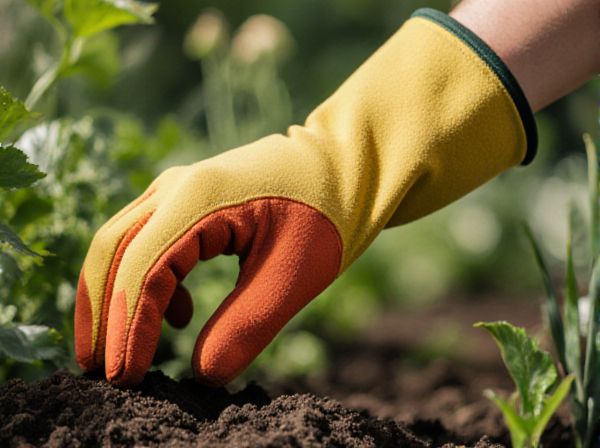
No-dig gardening vs Traditional digging Illustration
No-dig gardening preserves soil structure and fosters beneficial microorganisms by avoiding disturbance of the earth, promoting healthier root development and higher nutrient retention. Traditional digging can disrupt soil layers, leading to erosion, loss of organic matter, and diminished microbial activity. Embracing no-dig methods enhances soil fertility naturally, reducing the need for artificial inputs in edible plant cultivation.
Table of Comparison
| Aspect | No-Dig Gardening | Traditional Digging |
|---|---|---|
| Soil Disturbance | Minimal, preserves soil structure and microbes | High, disrupts soil layers and organisms |
| Weed Control | Effective with mulch layering | Requires manual removal or chemicals |
| Soil Erosion | Reduced erosion due to ground cover | Increased risk from exposed soil |
| Water Retention | Improves moisture retention | Can lead to drying out |
| Labor Intensity | Lower physical effort | Labor-intensive digging and turning |
| Crop Yield | Stable to improved in many cases | Variable, depends on soil health |
| Environmental Impact | Supports biodiversity and soil health | Can degrade soil and ecosystem |
Understanding No-Dig Gardening
No-dig gardening preserves soil structure by avoiding disturbance, promoting beneficial microbial activity and improving moisture retention. It reduces weed growth by maintaining a protective mulch layer, enhancing nutrient cycling through decomposing organic matter. Compared to traditional digging, no-dig methods foster healthier plant roots and sustainable soil ecosystems, reducing labor and erosion risks.
Key Principles of Traditional Digging
Traditional digging in gardening involves turning over the soil to a depth of 8 to 12 inches, which helps aerate the soil and incorporates organic matter or fertilizers thoroughly. This method disrupts weed roots and pests, promoting a well-tilled seedbed that supports root development and water infiltration. However, it can also disturb soil structure and beneficial microorganisms, requiring careful management to maintain long-term soil health.
Soil Health: No-Dig vs Digging
No-dig gardening preserves soil structure by minimizing disturbance, promoting beneficial microbial activity and earthworm populations essential for nutrient cycling. In contrast, traditional digging disrupts soil layers, leading to erosion, loss of organic matter, and reduced microbial diversity. Studies show no-dig methods increase soil carbon content by up to 30%, enhancing fertility and moisture retention compared to conventional digging.
Impact on Soil Microbiology
No-dig gardening preserves soil microbiology by maintaining the natural structure and organic layers, which supports beneficial microbes and fungi essential for nutrient cycling and plant health. Traditional digging disrupts soil ecosystems, breaking fungal networks and exposing microorganisms to air and predators, reducing microbial diversity and activity. Studies show no-dig methods increase microbial biomass and enzymatic activity, enhancing soil fertility sustainably over time.
Weed Control Methods Compared
No-dig gardening reduces weed growth by maintaining soil structure and preserving beneficial organisms that suppress weed seeds, unlike traditional digging which disturbs soil layers and promotes weed seed germination. Mulching is a key weed control in no-dig methods, effectively blocking sunlight and preventing weed establishment. In contrast, traditional digging often requires repeated hoeing or herbicide use to manage weeds emerging from disturbed soil.
Water Retention and Drainage Differences
No-dig gardening enhances water retention by maintaining soil structure and organic matter on the surface, reducing evaporation and improving moisture levels. Traditional digging disrupts soil layers, often leading to increased drainage and faster water runoff, which can result in drier soil conditions. This difference makes no-dig methods more effective for sustained hydration and healthier plant growth in edible gardens.
Crop Yield and Plant Health Outcomes
No-dig gardening significantly enhances crop yield by preserving soil structure and promoting beneficial microbial activity, which leads to healthier root development and increased nutrient availability. Traditional digging disrupts soil ecosystems, often causing compaction and reduced aeration that can impair plant health and limit productivity. Studies show no-dig methods boost long-term soil fertility and resilience, resulting in more robust crops with better resistance to pests and diseases.
Labor and Time Investment
No-dig gardening significantly reduces labor and time investment by eliminating soil turning, which preserves soil structure and minimizes weed disruption. Traditional digging requires extensive physical effort and hours spent breaking up compacted soil, often leading to longer planting preparation. By maintaining soil health and reducing manual work, no-dig methods streamline garden management and boost productivity.
Sustainability and Environmental Impact
No-dig gardening enhances sustainability by preserving soil structure, promoting biodiversity, and reducing erosion compared to traditional digging methods that disrupt soil ecosystems and increase carbon emissions. This approach minimizes soil disturbance, maintaining natural microbial activity which supports healthier plant growth and improves long-term soil fertility. Furthermore, no-dig gardening decreases water runoff and nutrient loss, contributing to more efficient resource use and lower environmental impact.
Choosing the Best Method for Edible Gardens
No-dig gardening preserves soil structure and enhances microbial activity, promoting healthier root systems crucial for edible plants like tomatoes and carrots. Traditional digging improves aeration and weed control but can disrupt beneficial organisms and soil layers essential for nutrient cycling. Selecting the best method depends on soil condition, crop type, and long-term sustainability goals to maximize yield and soil health in edible gardens.
No-dig gardening vs Traditional digging Infographic

 gardendif.com
gardendif.com